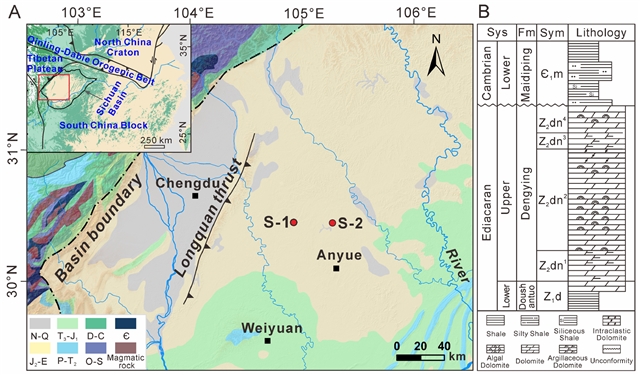
烃类演化是全球有机碳循环的重要组成部分,控制着地球地壳中烃类相的分布。然而,由于缺乏可靠的地质记录,油气相演化的路径和边界条件仍缺乏明确的认识。
研究组发现了一个独特的顺序圈闭油气组合,即湿气(C1/∑C1-5=0.74±0.030.91±0.01)和干气(C1/∑C1-5=0.96±0.01)1)四川盆地中部埃迪卡拉系白云岩储层流体包裹体,限制了原位烃相演化的途径和条件。值得注意的是,早期圈闭油(~247Ma)表现出异常低的成熟度(0.75% ~ 0.97% vs. 2.67% ~ 2.79%)。
这些原油夹杂物的形成可归结为三个关键过程:(1)夹杂物原油裂解过程中的压力积聚;(2)挥发性组分因老化而泄漏;(3)重烃在重新平衡后的原油中保留。相反,储层油发生原位裂解,并依次转化为湿气(~197Ma)和干气(~116Ma),随温度升高。在此过程中,识别出一种流体超压(如197~182兆帕期间达59~86兆帕,116~109兆帕期间达114~151兆帕)与压力释放的自调节机制,该机制促进了含烃流体的运移。通过将共存含水包裹体分析与埋藏史重建相结合,首次精确刻画了长期热演化储层中石油(≤156℃)与湿气(≤213℃)的保存窗口。这些发现为深层烃类演化与油气勘探研究提供了新的启示。
附:英文原文
Title: Fluid inclusion records abnormally low-maturity oil and hydrocarbon evolution in high-temperature reservoirs
Author: Dongquan SUN, Xiaolin WANG, Wenxuan HU, Xuesong LU, Junjia FAN, Shaobo TANG
Issue&Volume: 2025/10/14
Abstract: Hydrocarbon evolution is a crucial part of the global organic carbon cycle, and controls the distribution of hydrocarbon phases within the Earth’s crust. However, the pathway and boundary conditions of hydrocarbon phase evolution remain poorly constrained due to the lack of reliable geological records. Here we present a unique assemblage of sequentially trapped oil, wet gas (C1/∑C15=0.74±0.030.91±0.01) and dry gas (C1/∑C15=0.96±0.011) fluid inclusions from the Ediacaran dolomite reservoirs in the central Sichuan Basin, South China, which constrains the pathway and conditions of in situ hydrocarbon phase evolution. Notably, the early trapped oil inclusions (~247Ma) exhibit abnormally low maturity (0.75%0.97% vs. 2.67%2.79% VRE for reservoir pyrobitumen). The formation of these oil inclusions is attributed to three key processes: (1) pressure buildup during inclusion oil cracking; (2) leakage of volatile components through decrepitation; and (3) retention of heavy hydrocarbons in the re-equilibrated oil inclusions. In contrast, the reservoir oil underwent in situ cracking and was successively transformed to wet gas (~197Ma) and dry gas (~116Ma) with increasing temperature. During this process, a self-regulating mechanism of fluid overpressurization (e.g., 5986MPa in 197182Ma and 114151MPa in 116109Ma) and pressure release was identified to facilitate the hydrocarbon-bearing fluid migration. Integration of coexisting aqueous inclusion analyses with burial history reconstruction refines the oil (≤156°C) and wet gas (≤213°C) preservation windows, respectively, in prolonged heating reservoirs. These findings shed new light on hydrocarbon evolution and petroleum exploration in deep strata.
DOI: 10.1007/s11430-025-1669-x
Source: https://www.sciengine.com/SCES/doi/10.1007/s11430-025-1669-x
Science China Earth Sciences:《中国科学:地球科学》,创刊于1952年。隶属于施普林格·自然出版集团,最新IF:5.7
官方网址:https://www.sciengine.com/SCES/home
投稿链接:https://mc03.manuscriptcentral.com/sces
